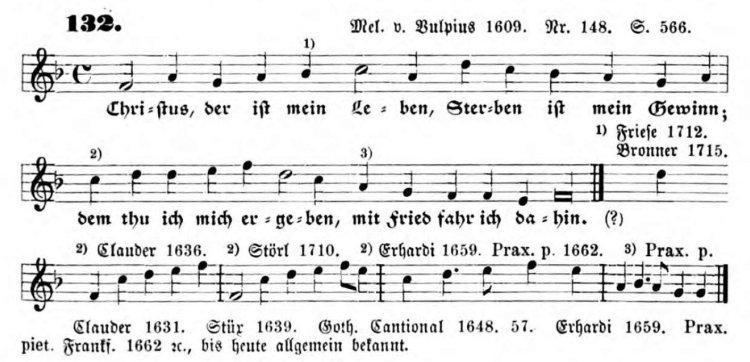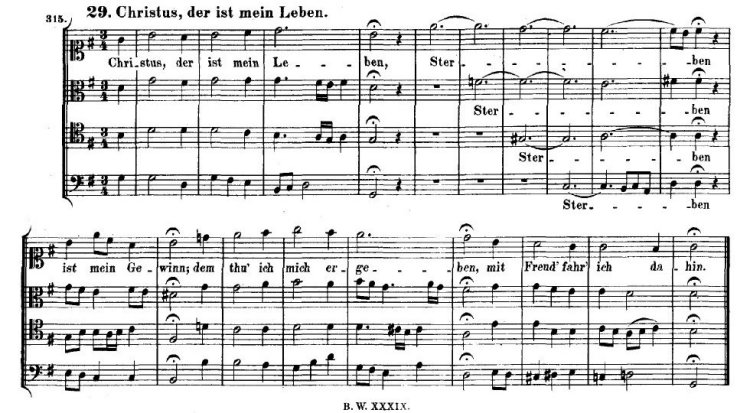|
|
Chorale Melodies used in Bach's Vocal Works
Christus, der ist mein Leben |
|
Melody & Text | Use of the CM by Bach | Use of the CM by other composers | English Hymnals Using the German CM |
| |
|
Melody & Text: |
|
The comforting Death & Dying chorale, "Christus, der ist mein Leben," Christ is my life) is best known today in Lutheran hymnals as "Abide with Us, Our Saviour," or "Abide, O Dearest Jesus." The latter is found in the current Evangelical Lutheran Worship (2006), No. 539 under the rubric "Sending" as a five-stanza liturgical closing hymn and previously in the Lutheran Book of Worship (1978) as No. 263 for the same "Close of Service." "Abide, O Dearest Jesus" previously was initially found in The Lutheran Hymnal (1941) No. 53 for the same purpose in six stanzas with the incipit based on Luke 24:29, "But they constrained him, saying, Abide with us" (kjv) in the post-Easter Walk to Emmaus. It is also found in this hymnal as No. 597, Death & Burial, "For Me to Live is Jesus," the eight-stanza Catherine Winkworth adaptation of the original, anonymous, before 1608 chorale in nine stanzas (EKG 316, http://www.bach-cantatas.com/Texts/Chorale038-Eng3.htm), the incipit based on Phi. 1:22, " But if I live in the flesh, this is the fruit of my labour: yet what I shall choose I wot not" (kjv). It is set to the Melchior Vulpius 1609 melody (Zahn 132, Christus, der ist mein Leben). The same two hymns are today found the Lutheran Service Book (2006) under the same rubrics, Nos. 742 and 919.
The text author is unknown except as "S. Graff," set to the melody of composer M. Vulpius (c.1560/70-1615) and first published in his "Ein schön geistlich Gesangbuch (Geneva, 1609), composed in ballad style with emphasis on the child-like naivete text as a prayer for the dying in the period of Lutheran Orthodoxy (c.1577-1617), Vulpius being its leading hymn composer. The first chorale in the category of "Death and Dying" (Von Tod und Sterben) was Johann Walther's 1524 chorale, “Mitten wir im Leben sind," a vernacular paraphrase of the Latin antiphon, Media vita in morte sumus (In the midst of life we are in death; see http://www.bach-cantatas.com/LCY/M&C-Trinity16.htm, "Motet Media vita, Luther hymn ‘Mitten wir’"), Bach setting BWV 383 (https://www.youtube.com/watch?v=5gR8wQqA-OA).
The hymn category of "Death & Dying" gained prominence and application during the third Reformation period of the Thirty Years War (1618-48) and its aftermath with the individual's search for understanding and consolation. For example, the Vulpius melody to the anonymous text, "Christus, der ist mein Leben," was also known as "Ach bleib mit deiner Gnade" (EG 347, Ah abide with thy grace), became well-known following its publication in the 1620s edition of Suspira Temporum (Rinteln 1628), with the text attributed to persecuted Lutheran pastor Joshua Stegmann (1588-1632). |
|
By Bach's time, the Period of Pietism (1675-1750), "Death & Dying was one of the largest categories and was found near the omnes tempore (Ordinary Time) thematic end of the hymnbooks. For example Bach's Neu Leipziger Gesangbuch of 1682 lists 65 such entries (NLGB Nos. 324-389), with "Christus, der ist mein Leben" as No. 369. Bach initially listed in the Vulpius melody in his Weimar Orgelbüchlein (Little Organ Book) chorale preludes as No. 134 under “Death and Dying” but not set. Instead he probably utilized his youthful Neumeister collection organ chorale prelude with the same title, BWV 1112, before 1710 (https://www.youtube.com/watch?v=AEklFnxH89o), which is similar to plain chorale BWV 282 (https://www.youtube.com/watch?v=mENwJuSn32I). Bach may have composed this four-voice setting originally for his 1716 extended funeral cantata for Weimar Prince Johann Ernst, "Was ist, das wir Leben nennen" (What is this that we call life?), just accepted as BWV 1142 in the new Bach Works Catalogue, 3rd edition (https://www.bach-digital.de/receive/BachDigitalWork_work_00001531?lang=en) with the first verse as No. 19 and the third, "Nun hab nun überwunden" (Now I have overcome), as the penultimate No. 21, set to the same harmonization.
In 1723, Bach set the first portion of BWV 282 to open his chorale chorus setting (also in 3/4 time) of "Death & Dying multi-chorale Cantata BWV 95, “Christus, der ist mein Leben,” for the 16th Sunday after Trinity (http://www.bach-cantatas.com/Scores/BWV095-V&P.pdf, https://www.youtube.com/watch?v=sZ7R43p9SyI; details http://www.bach-cantatas.com/BWV95-D4.htm). The other four-part harmonization, BWV 281, "is one of several Bach chorales that are based on simple hymn settings from the Neu Leipziger Gesangbuch," says Luke Dahn, that Bach embellished (http://www.bach-chorales.com/BWV0281.htm, https://www.youtube.com/watch?v=UgMuqQeJuYc). The fourth and last line of the hymn first stanza, "Mit Fried fahr ich dahin" (with joy I depart), is a paraphrase of Simeon's canticle, Nunc dimittis (Luke 2:29, https://en.wikipedia.org/wiki/Nunc_dimittis). The chorale also is found in the 1736 omnibus sacred song collection, Schemelli Gesangbuch, as No. 842 (76 Death Songs), and attributed to S. Graff, with many new pietist songs, for which Bach served as music editor.
William L. Hoffman (October 8, 2018) |
|
Melody: Zahn 132 |
|
The composer of the melody is Melchior Vulpius. It first appeared in print in Ein schön geistlich Gesangbuch, Jena 1609. |
 |
|
Text: Christus, der ist mein Leben (EKG 316) |
|
Unknown source from before 1608. |
|
Hymnal versions Bach may have known: |
|
A possible source which Bach may have used is the Gotha Hymnal from 1715. There the melody appears as follows: |
|

|
| |
|
Use of the Chorale Melody by Bach: |
|
Text: Christus, der ist mein Leben | EKG: 316
Author: Anon (before 1608) |
|
Chorus (Chorale) [S,A,T,B] & Recitative [T] Christus, der ist mein Leben (Mvt. 1) from Cantata BWV 95 (verse 1)
Ref: Br 315; BC A136:1
Music Examples: Mvt. 1 (Leusink) [ram] |
|

|
|
Untexted: |
|
Chorale Christus, der ist mein Leben, BWV 281
Ref: RE 6; Br 7; KE 6; Birnstiel 8; AmB 46II p.165; Levy–Mendelssohn 33; Fasch p.27; BGA 28; BC F30:1
Score: PDF | Music Examples: Chorale (MG) [midi] |
|

|
 |
|
Chorale Christus, der ist mein Leben, BWV 282
Ref: RE 316; Br 315; KE 316; Birnstiel 315; AmB 46II p.78; BGA 29; BC F30:2
BWV 282 vel 95/1 w/o instruments (Br. 315) [the same as BWV 95/1]
Score: PDF | Music Examples: Chorale (MG) [midi] |
 |
|
Chorale Prelude Christus, der ist mein Leben, BWV 1112
Ref: BC K185 |
|

|
| |
|
Use of the Chorale Melody by other composers: |
|
Samuel Scheidt (1587-1654):
SSWV 525 Christus der ist mein Leben 4-pt. setting |
|

|
|
Johann Schelle (1648-1701):
Christus, der ist mein Leben, Cantata 5 voices, 4 violins, 4 violas, bassoon, bc. |
|
Johann Pachelbel (1653-1706):
Chorale Variations on Christus, der ist mein Leben, T. 81 (1683) |
|

|
|
Georg Philipp Telemann (1681-1767):
Christus der ist mein Leben (M. Vulpius), Cantata 1:138 (1754) |
|
Johann Gottfried Walther (1684-1748):
Christus, der ist mein Leben 2 Chorale Preludes for Organ |
|

|
|
Johann Christian Rinck (1770-1846):
Variations on Christus, der ist mein Leben for organ |
|
Ján Levoslav Bella (1843-1936):
Fantasy on the chorale Christus, der ist mein Leben (1918). |
|
Max Reger (1873-1916):
Christus der ist mein Leben, Chorale Prelude for Organ, Op. 67/5 (1902)
Christus der ist mein Leben, Chorale Prelude for Organ, Op. 79b/9 (1901-1903) |
|
Günter Raphael (1903-1960):
Fantasie über den Choral Christus, der ist mein Leben Organ (1968) |
| |
|
English Hymnals using the German Chorale Melody |
|
New English Hymnal:
Lord, who shall sit beside thee (after J.S. Bach) (tune Christus Der ist mein leben), No. 175 |
| |
|
Sources: NBA, vols. III/2.1 & 2.2 in particular [Bärenreiter, 1954 to present] and the BWV ("Bach Werke Verzeichnis") [Breitkopf & Härtel, 1998]
The PDF files of the Chorales were contributed by Margaret Greentree J.S. Bach Chorales
Software: Capella 2004 Software, version 5.1.
Prepared by Thomas Braatz & Aryeh Oron (September 2005), William L. Hoffman (October 2018) |
|
|